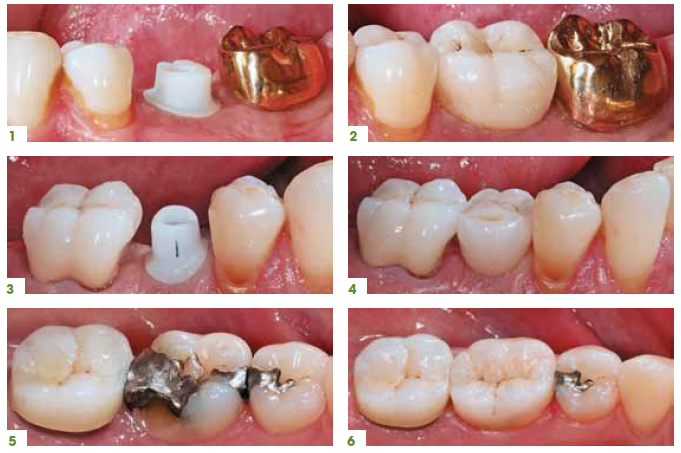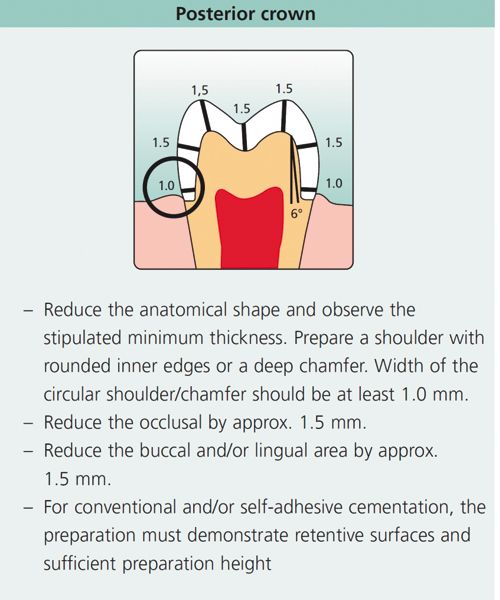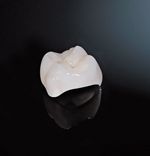IPS e.max success story may make PFMs quite rare
By now everyone is well aware of the successes of IPS e.max, which has proven to deliver strong, esthetic restorations in all areas of the mouth. In fact, long-time prosthodontist Dr. Kenneth Malament, a world-renowned researcher and educator on all ceramics, says his choice is Ivoclar Vivadent’s ceramic for all of his single unit restorations. But where this material really has a unique spot is in the posterior areas.

Trending Article: Top 25 Women in Dentistry 2014
Today, a number of clinicians are using zirconia in the posterior, but Dr. Malament, DDS, M.Sc.D., believes IPS e.max is still the best option for posterior single units, the bread and butter cases for many dentists. While many patients and clinicians are moving away from PFMs, they should be aware that while zirconia is an option that provides significant strength, lithium disilicate delivers the best survival data, economics and better esthetics, according to Dr. Malament.
“e.max is the best we have ever worked with,” said Dr. Malament, who has had a prosthodontics practice in Boston since 1977.
The material and science advances that helped bring about a product like IPS e.max may very well lead to a changing of the guard for those clinicians who had grown accustomed to the traditional porcelain fused to metal (PFM) restorations.
According to Ivoclar Vivadent’s IPS e.max Scientific Report Vol. 02 (2001 – 2013), which is available online at: ivoclarvivadent.us/emax/science, more than 75 million IPS e.max restorations have been delivered, and the crown survival rate is 98.2%. Dr. Malament’s results have been even more impressive.
Originally, Dr. Malament and his colleagues extensively used and studied Ivoclar Vivadent’s Empress with tremendous results. Since switching to IPS e.max, his success numbers have been staggering.
“I have researched all ceramic materials 32 years and have a database where every all ceramic restoration I have ever done is studied with 29 different confounding variables,” said Dr. Malament, who practices with Dr. Dan Nathanson, Professor, Chairman Restorative Sciences, Boston University School of Graduate Dentistry, and Dr. Hans Peter Weber, Professor, Chairman Restorative Sciences, Tufts University School of Dental Medicine. “Of all of the materials we have ever studied, Empress, at the time, was the best from the point of years of survival. I have cemented up to today, 2,133 Empress restorations over 265 months with 103 failures. A failure is a fractured crown that requires replacement. A chipped restoration is also studied in the database and of the 31 chipped Empress restorations all were easily smoothed and did not need to be replaced.”
Click here to read about the success rates that Dr. Malament had with IPS e.max.
Now that he uses IPS e.max, the success rate is significantly higher than those impressive Empress figures.
Webinar: Learn the real value of 3D printing in the dental lab
“As of today, and at 85-86 months (7 years) 546 patients, 1,896 units and I have but one failure,” he said. “We’ve never seen this performance in a ceramic material before ever.”
These are the types of numbers that keep scientists up at night. Dr. Malament and his research colleagues are more than impressed by the data they have accumulated and the science on IPS e.max.
“The one failure has been studied extensively. We were totally obsessed with how this happened and needed to understand the fracture mechanics of he event,” he said. “The lone ‘failure’ was a patient who was a severe bruxer who after four years fractured the lithium disilicate.”
Dr. Malament has confidence that IPS e.max restorations will not only look great, but last long, keep his patients happy and his practice thriving.
“Obviously we have done a significant number of anterior and posterior crowns. IPS e.max restorations are etchable when cemented, providing me with great confidence. This is not always the case with other materials,” he said. “It has been a extraordinary material. I’ve never seen a material behave this way. Never, never, never.”
Dr. Malament, who also uses IPS e.max regularly for minimally invasive inlays and onlays, says the material has helped his practice profits grow dramatically. But just as important is the confidence it brings in knowing that the restoration will not have to be redone.
“I look at everything from the point of view of cost effectiveness,” Dr. Malament said. “The IPS e.max lithium disilicate has been the most unusual material I have ever ever worked with. It’s been an amazing material.”
He adds that Ivoclar Vivadent is a company that listens to clinicians and responds. He also noted that they have material advances planned in the near future that are designed to deliver an even more esthetic ceramic.
“They (Ivoclar Vivadent) have been the most responsive manufacturers in prosthodontics,” he said. “They’re just a very responsible company to us.”

Before & After Cases
[ Figs. 1-6 ] Three different Dr. Kenneth Malament cases: The mandibular first molar implant is restored with an IPS e.max cemented to the titanium abutment; the crown is acid etched and silaned before cementation (Figs. 1-2). The mandibular first bicuspid implant is restored; an IPS e.max crown is cemented to the abutment using an all resin cement (Figs. 3-4). The mandibular first molar has a distal lingual wall fractured off. It is restored with an IPS e.max partial coverage onlay restoration with the same preparation that one would use for a gold onlay with chamfer margins (Figs. 5-6).
Conclusion
“I do not see the rationale for doing anything but IPS e.max anywhere in the mouth,” Dr. Malament said. “For two reasons academically for me. Number one, lithium disilicate wears almost exactly like natural tooth. Zirconia if it’s polished does very well but if it’s rough, and as dentists we often have to adjust occlusions…once it’s rough and not polished perfectly, it is abrasive. Now, I’m not saying that matters… look, we’ve all worked our whole careers in metal ceramics. However, you can’t compare any material we have in the posterior to lithium disilicate.
“Secondly, I can’t see one advantage it has over the lithium disilicate in a single unit situation, and there is no comparison to it in terms of esthetic results. Zirconia is so smooth internally and has been reported to often come off teeth after cementation. Since e.max is etchable and can be cemented with either glass ionomer resin or resin cements I have not experienced a crown coming off. “
Another factor about IPS e.max is the ceramic stratification and layering that can enhance the esthetic results.
“Our research team headed by Dianne Rekow and Van Thompson and just confirmed by Dr. Robert Kelly’s group at University of Connecticut proved that if you add the fluorapetite veneering ceramic at 0.5 mm, the bi-layered restoration is stronger than the virgin monolithic. That to me is unbelievable.
“Dentistry is a hard business. Our overhead is high. We have great staffs, but they’re expensive. You have to know that the work you do is going to have 1. Value and 2. It’s going to survive so you don’t have to remake it. And lose money.
There has never been a story like this in dentistry yet.”
Esthetics and strength: While IPS e.max is the “go to” material of choice for anterior esthetics, it has a proven track record for performance in the posterior region of the mouth as well.
Editor’s Note: Ivoclar Vivadent and Dr. Malament would like to extend a special thanks to Thomas Sing and Brendon Cornell for their outstanding laboratory skills and craftsmanship.

5 things to get you started with ivoclar vivadent’s ips e.max
If you’re looking to implement IPS e.max into your practice, here are 5 important things you need to know. They’ll help you get the best results and also ensure you find the best dental laboratories to partner with as you prepare to deliver great-looking restorations to your patitents.
Determine the ideal treatment plan for the patient. With today’s advancements in all-ceramics, virtually any clinical restorative need can be met. IPS e.max can be utilized for a vast majority of these cases, including single-unit posterior crowns which make up more than 70% of indirect restorative dentistry.
Consult with your laboratory to see if they utilize IPS e.max materials. There are more than 6,000 IPS e.max laboratories in North America (visit the IPS e.max Lab Finder at www.theworldspeaksemax.com).
Ensure that proper preparation guidelines are met in accordance with clinical needs (see preparation diagram at left).
Consider your preparation design and material thickness when determining cementation type and protocol. The proper combination prep design and cement will greatly increase the longevity of the restoration.
Deliver a successful case to the patient.
Nosti’s take on why IPS e.max can be the single ceramic your office uses

Previously in DPR, Dr. John Nosti of Mays Landing New Jersey and Manhattan shared his thoughts on why he likes IPS e.max so much.
I’ve been using IPS e.max pretty much since it hit the market. I do a lot of single-unit posteriors, and at the time I was experiencing some failures with zirconia based ceramic layered restorations. I was looking for something that could replace that in my office.
Trending Article: The dental professional's role in stopping domestic violence and abuse
Why was IPS e.max the product you were looking for?
I’ve been a metal-free doctor for awhile, and now I am more confident in all-ceramic restorations for single tooth dentistry patients and likewise with my full mouth rehab patients, especially for patients with a lot of wear. IPS e.max has been the savior for those patients. You get the esthetics you have been accustomed to with Empress, you can bond and be conservative with cases with its ability to be very thin while maintaining the strength. In summary, it’s better than any all-ceramic restoration on the market that you can bond with. It’s conservative yet strong, and you can get the layered look with the monolithic strength.
What are the benefits to your patients?
They leave with a restoration that looks like their tooth did before they required that restoration. You don’t have to take away a lot of tooth structure because e.max is thin but strong, so patients have longevity with their great looking restoration.
For dentists who aren’t using IPS e.max yet, why would you encourage them to do so?
I believe there are multiple reasons to use IPS e.max over a porcelain fused to high noble metal. First of all the expense of gold. Single restorations can cost you a lot of money, and when you’re done with that restoration, it’s opaque so it doesn’t have the natural appearance of tooth structure. That isn’t the case with IPS e.max. There’s also a cost benefit to the practice, yet it’s a more esthetic restoration that looks more like natural tooth structure and the adjacent teeth. It has about 106 ingots so the ability to match adjacent tooth structure is there. You also have strength. Its flexural strength is roughly 400 MPa, which is twice as strong as any porcelain fused to metal crown. One of the final benefits is its ease of use. The dentist has the ability to use it as a bonded restoration or use it as a conventionally cemented restoration. There are not a lot of restorations available that give you the ability to do both.
You have strength, you have appearance, you have cost and you have ease of use. It really can be the single ceramic your office uses.
Featured Product
IPS e.max

IPS e.max enables multiple fabrication techniques and offers patented lithium disilicate-an advanced material that demonstrates the highest strength in glass-ceramics. IPS e.max Press and IPS e.max CAD both fulfill the high strength and optimal esthetics required for pressing or milling anterior and posterior crowns. IPS e.max Press is also indicated for 3-unit anterior bridges. IPS e.max esthetics, high strength, and predictable shade matching make it the material of choice for even the most difficult combination cases. Now, you can produce the highest quality esthetic restorations using the most progressive fabrication methods with the industry’s most innovative materials.
This article originally appeared in the September 2014 issue of DPR.